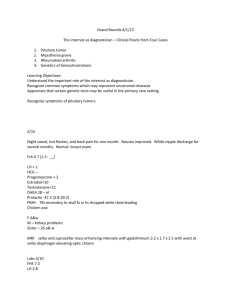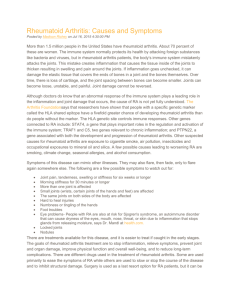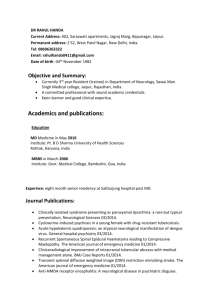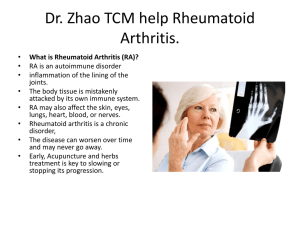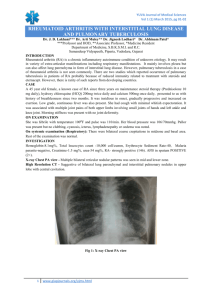Periodontitis-Associated RA
advertisement
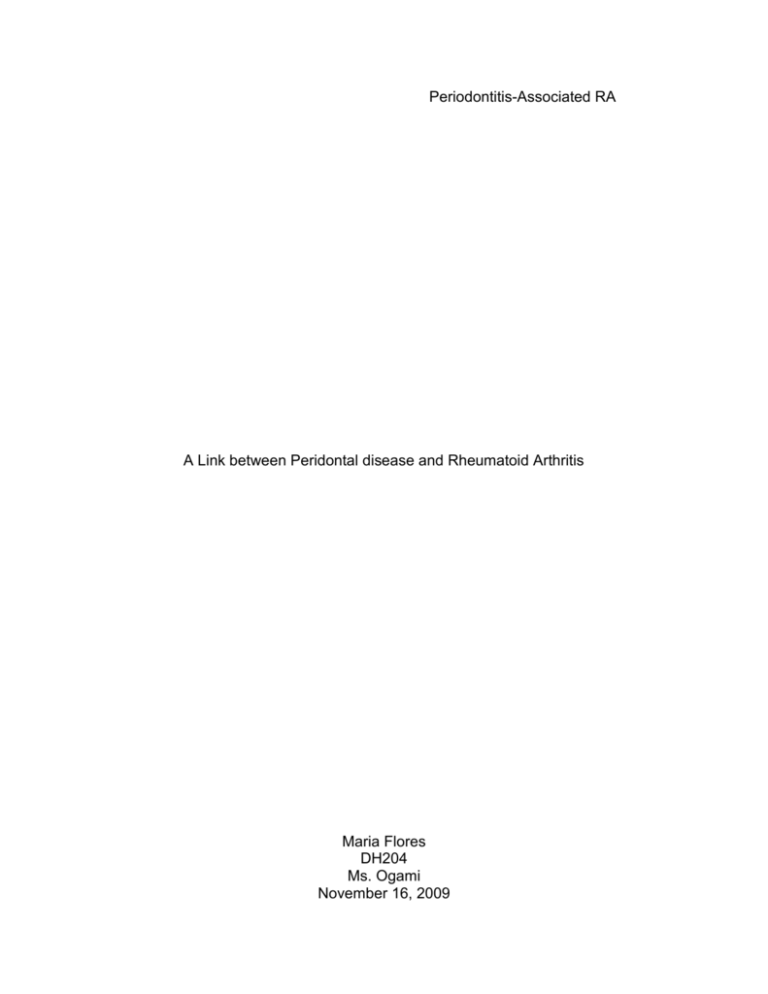
Periodontitis-Associated RA A Link between Peridontal disease and Rheumatoid Arthritis Maria Flores DH204 Ms. Ogami November 16, 2009 Periodontitis-associated RA 1 Introduction Rheumatoid arthritis is a chronic autoimmune disease with inflammation of the joints and marked deformaties, researchers have found a possible link between rheumatoid arthritis and periodontal disease. In a recent study, 57 patients with rheumatoid arthritis and 52 patient’s wihtout RA were examined, it was suggested that patients with Rheumatoid arthritis had a greater periodontal attachment loss compared to patients without RA (Pischon et al., 2008). It is also been found that P. gingivalis a bacteria that is associated with peridontal disease is the only bacteria known to express the (PAD) Peptidylarginine deimninase enzyme which is strongly associated Rheumatoid Arthritis (Liao, Feng 2008). The association between RA and Periodontal disease deserves much interest for more research since both diseases can lead to detrimental effects. If we as clinicians can help alleviate symptoms of either one of these diseases it can lead to a better quality of life. The link between Periodontal Disease and Rheumatoid Arthritis Rheumatoid Arthritis is a chronic autoimmune disease characterized by inflammation of the lining or synovium of the joints; it is believed to result from an "autoimmune" process in which the body's immune system attacks itself. It is a system-wide disease that usually last for many years. In some patients, RA affects such organs as the heart, lungs, and eyes. Patients with active RA often feel feverish or ill. Women are more likely than men to develop rheumatoid arthritis possibly connected to flucuaiton of women hormones during pregnancy Periodontitis - Associated RA 2 and menopause. Testing and diagnosis for RA include blood test to check for rheumatoid factor and x-rays to check for bone erosion. Test results can also produce positive-negative results indicating the possibilities of developing RA in the future. Periodontal disease is a bacterial infection that destroys the attachment fibers and supporting bone that hold the teeth in the mouth. Left untreated, it can lead to tooth loss. Recent research has indicated that both of these diseases, rheumatoid arthritis and periodontal disease have common features, both are characterized by symptoms of inflammation due to inflammatory mediator cells causing pain, swelling and tenderness and eventually bone destruction. Both disease share similar immune responses triggered by inflammation targeting the oral cavity or synovial membrane, both diseases have raised titiers of IL-10, IL1α, tnfα, LTα and low titers of autoanitbodies to IL-1α, and IL-6. One of the main bacteria that are responsible for severe forms of periodontal disease is Porphyromonas gingivalis, a gram negative anaerobic pathogenic bacterium. According to Feng et al. (2008) P. Gingivalis is the only Prokaryotic orgnism that produces (PAD) Peptidylarginine deiminase enzyme which is a specific marker for rheumatoid arthritis. Through a process called Post-transitional conversion, P. Gingivalis converts the Peptidylarginine enzyme into citrulline (citrullination) an α amino acid which may suggest that periodontal infection can directly impact people with rheumatoid arthritis facilitating inflammation and also possibly indicate pathogenesis for RA. Peridontitis-Associated RA 3 In a study,109 subjects were selected to assess an association between RA and periodontitis, 57 of those subjects had rheumatoid arthritis, eight males and 49 females, Subjects with RA were required to meet at least four criteria of symptoms for RA which included morning stiffness, arthritis of three or more joint areas, arthritis of hand joints and radiographic findings. The remaning 52 subjects did not have RA and were composed of 43 females and 9 males. All subjects were examined and assessed for Clinical attachment loss (CAL), periodontal disease (PD), lost teeth (n), Plaque Index (PI), bleeding on probing (BOP), decayed missing filled teeth(DMFT) index, Gingival index (GI) and TMJ symptoms. The findings indicated according to (table 2) Pischon et al. (2008) that there was a significant difference in patients with RA compared to the control group. The association between RA and periodontal disease is brought a lot of attention to rheumatologist at the Case School of Medicine and University hospitals Case Medical center where rheumatologist for eight weeks were observing patients receiving periodontal therapy and found that at the end of those eight weeks the severity of the arthritis was reduced. In addition, they suggested that periodontal therapy combined with (DMARD) disease modifying antirheumatic drugs and (anti-TNF) showed that patients not only had relief of the RA inflammation, but the periodontal status of these patients was significantly improved (Case Western Reserve University, 2007, p. 2). Currently there is no cure for Rheumatoid arthritis but there is a promise of a P. Gingivalis Vaccine. Severe periodontal disease can be arrested but the bone destruction is irreversible, in either case both disease need to be monitored closely for major Periodontitis-Associated Ra 4 changes with a specialist and dental practitioner. For the dental health practitioner, it is especially important to follow up closely with RA patients since there seems to be evidence connecting periodontal disease with RA being aware of symptoms that a patient may exhibit like tenderness of the joints in the hands may indicate a symptom of RA. With the recent evidence of periodontal disease and RA, Rheumatologist should also refer patients with RA to visit their dentist for a prescreening to prevent the onset of periodontal disease. Alleviating symptoms of RA through medication and periodontal therapy will not only improve the quality of a person’s life but also improve their periodontal health as well. Periodontits-associated RA 5 References Case Western Reserve University. (2007). Rheumatology Research. Linking Rheumatoid Arthritis and Periodontal Disease: Enhancing the Ability to Treat Both. (From Value of Research published by Case for, Predominant research). Retrieved from casemed.case.edu/medicine/resrheum.htm Depinder, K. Modi., Vipinder, S. Chopra., Bhau, Usha. (2009). Rheumatoid arthritis and periodontitis: Biological links and the emergence of dual purpose therapies, 20, (1) 86-90. Gonzalez, D., Tzianabos, O, A., Genco, A, C., & Gibson, C. F. (2003). Immunization with Porphyromonas gingivalis Capsular Polysaccharide Prevents P. gingivalis-Elicited Oral Bone loss in a Murine Model. Retrieved from www.ncbi.nlm.nih.gov/pmc/articles/PMC152101/ Liao, Feng., Zubing, Li., Wang, Yining., Shi, Bin., Gong, Zhongcheng., Xiangrong, Cheng., (2008). Porphyromonas gingivalis may play an important role in the pathogenesis of periodontits-associated rheumatoid arthritis. Retrieved from www.elsevier.com/locate/mehy. Medical hypotheses 72 (2009), 732-735. Mercado, F. B., Marshall, R. I., Klestov, C. A., Bartold, M. P., (2001). Relationship Between Rheumatoid Arthritis and Periodontitis.Journal of Periodontology Online. J Periodontal 2001: 72: 779-787. Pischon, N., Pischon, T., Kroger, J., Gulmez, E., Kleber, B. M., Bernimoulin, P. J., et al. (2008). Association Among Rheumatoid Arthritis, Oral Hygiene, and Periodontitis, 79 (6) 979-986.

